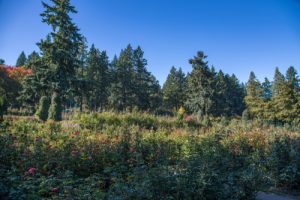Washington Park
It’s really little wonder that Portland’s Washington Park attracts 3.5 million visitors annually. After all, the park’s 410 acres is literally crammed full of attractions. In addition to the oldest zoo in the west and 2 superb museums, the park also boasts an impeccable Japanese garden, a historic rose garden, and a spectacular arboretum. I mean, what more could you ask for? There’s so much to see, in fact, that to do the park justice you’ll really have to visit it over and over again.
Washington Park’s Museums
Washington Park is home to two very different, but equally absorbing, museums, Portland Children’s Museum, and World Forestry Center’s Discovery Museum. For its part, the children’s museum is jam-packed with fun interactive activities that are spread across numerous exhibitions. The forestry museum, meanwhile, is housed in a spectacular wooden structure. As you would expect, every inch of the museum’s 20,000 square foot floor space is dedicated to teaching visitors about the multifaceted importance of trees. Highlights include a 5 million-year-old Giant Sequoia stump, an interactive display on the world’s forests, and a virtual tour through some of the planet’s most impressive forests.
Oregon Zoo
Oregon Zoo is a great place for a family day out. Set on 64 acres, the zoo is home to more than 2,200 animals. Highlights include orangutans, penguins, tigers, polar bears, and Asian elephants.
International Rose Test Garden
All in, this spectacular rose garden boasts no fewer than 722 varieties of rose across 10,000 individual plants. Between late May and September – the peak bloom season – the garden is nothing short of a kaleidoscopic wonderland of color and perfume. Even when the roses aren’t at their very best, the expansive views afforded by the garden’s hilltop location make it well worth a visit.
Portland Japanese Garden
Portland’s very own little slice of the land of the rising sun is not to be missed. Especially not, if you’re looking for some respite from the hustle and bustle of modern life. The garden’s peaceful 12-acre plot is divided into 5 very different areas. Some are a riot of exuberant planting.
Whereas others are pared back to the point of minimalism. All, without exception, however, exude a profound sense of tranquility.
Hoyt Arboretum
The wondrous Hoyt Arboretum boasts a mind-boggling 2,300 species of trees and shrubs. Within the arboretum’s 190 acres, you’ll find everything from monkey puzzles to Japanese larches, crape myrtles to European bladdernuts, and Joumana snow gums to white-barked Himalayan birches – all of which are helpfully labeled. Basically, there’s little you won’t find while exploring the arboretum’s extensive network of hiking trails.
Washington Park’s Early History
Washington Park wasn’t always as impressive as it is today. In fact, the park began its life all the way back in 1871 as a rather unprepossessing 40-acre tangle of unruly undergrowth. From that point on, development – under the attentive stewardship of the park’s first keeper, Charles Myers – was steady if not spectacular. An early milestone was reached in 1877 with the opening of the zoo. However, truth be told, it wouldn’t be until the turn of the 20th century that the park would really begin to take shape. By that point, Myers’ perseverance had paid off handsomely in the shape of ornamental gardens, manicured lawns, and a network of walkways and drives. Myers’ vision was the springboard from which the park as we know it today developed.
Getting to Washington Park
There’s no sugarcoating it, parking at Washington Park is extremely limited. As such, public transit is probably your best bet. Luckily, Washington Park is well served by light rail and bus. With respect to the MAX light rail network, both the light blue and red line stop at the park. Bus line 63 also serves the park.
On top of that, the park can also boast a free shuttle service dedicated to ferrying visitors between its numerous attractions. This service runs between April and October. That said, buses are most frequent – one every 15 minutes – between May and September.

